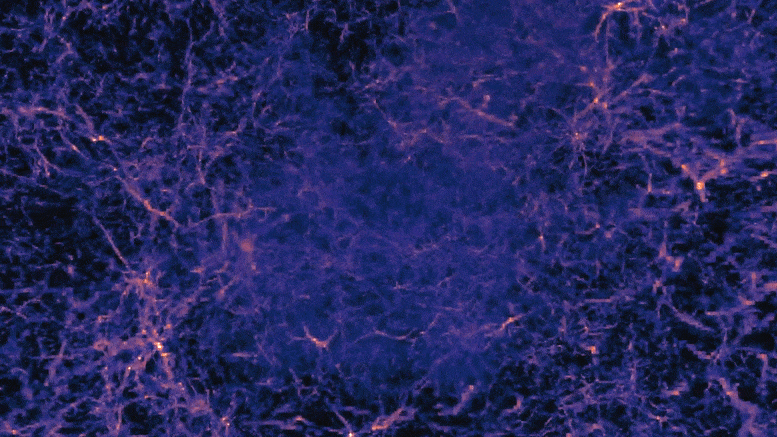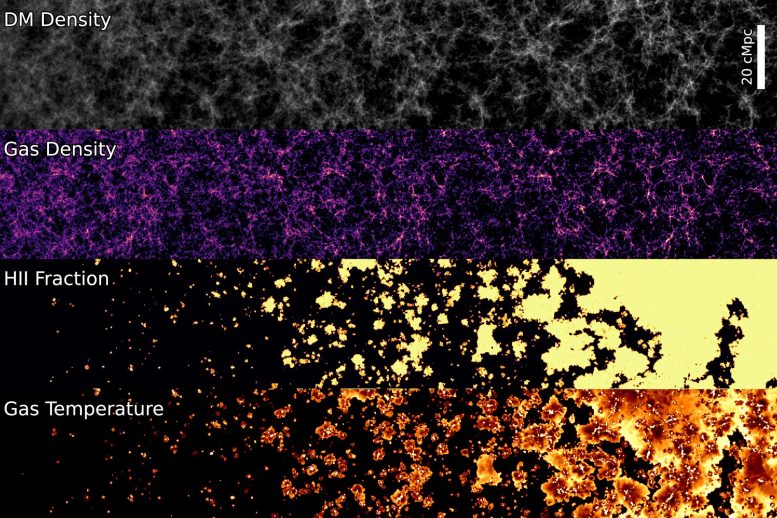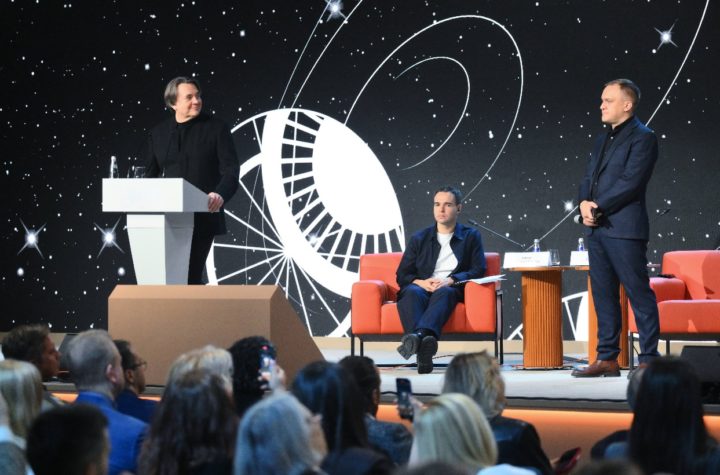
Мали клип за симулацију Тезана. Погледајте видео у чланку испод.
Назване по богињи зоре, Тезанове симулације прве милијарде година помажу да се објасни како је зрачење обликовало рани универзум.
Све је почело пре око 13,8 милијарди година огромном космичком „експлозијом” која је изненада и задивљујуће створила универзум. Убрзо се свемир за бебе драматично охладио и постао потпуно мрачан.
Затим, у року од неколико стотина милиона година касније[{“ attribute=““>Big Bang, the universe woke up, as gravity gathered matter into the first stars and galaxies. Light from these first stars turned the surrounding gas into a hot, ionized plasma — a crucial transformation known as cosmic reionization that propelled the universe into the complex structure that we see today.
Now, scientists can get a detailed view of how the universe may have unfolded during this pivotal period with a new simulation, known as Thesan, developed by scientists at MIT, Harvard University, and the Max Planck Institute for Astrophysics.
Named after the Etruscan goddess of the dawn, Thesan is designed to simulate the “cosmic dawn,” and specifically cosmic reionization, a period which has been challenging to reconstruct, as it involves immensely complicated, chaotic interactions, including those between gravity, gas, and radiation.
The Thesan simulation resolves these interactions with the highest detail and over the largest volume of any previous simulation. It does so by combining a realistic model of galaxy formation with a new algorithm that tracks how light interacts with gas, along with a model for cosmic dust.

Evolution of simulated properties in the main Thesan run. Time progresses from left to right. The dark matter (top panel) collapse in the cosmic web structure, composed of clumps (haloes) connected by filaments, and the gas (second panel from the top) follows, collapsing to create galaxies. These produce ionizing photons that drive cosmic reionization (third panel from the top), heating up the gas in the process (bottom panel). Credit: Courtesy of THESAN Simulations
With Thesan, the researchers can simulate a cubic volume of the universe spanning 300 million light years across. They run the simulation forward in time to track the first appearance and evolution of hundreds of thousands of galaxies within this space, beginning around 400,000 years after the Big Bang, and through the first billion years.
So far, the simulations align with what few observations astronomers have of the early universe. As more observations are made of this period, for instance with the newly launched James Webb Space Telescope, Thesan may help to place such observations in cosmic context.
For now, the simulations are starting to shed light on certain processes, such as how far light can travel in the early universe, and which galaxies were responsible for reionization.
“Thesan acts as a bridge to the early universe,” says Aaron Smith, a NASA Einstein Fellow in MIT’s Kavli Institute for Astrophysics and Space Research. “It is intended to serve as an ideal simulation counterpart for upcoming observational facilities, which are poised to fundamentally alter our understanding of the cosmos.”
Smith and Mark Vogelsberger, associate professor of physics at MIT, Rahul Kannan of the Harvard-Smithsonian Center for Astrophysics, and Enrico Garaldi at Max Planck have introduced the Thesan simulation through three papers, the third published on March 24, 2022, in the Monthly Notices of the Royal Astronomical Society.
Follow the light
In the earliest stages of cosmic reionization, the universe was a dark and homogenous space. For physicists, the cosmic evolution during these early “dark ages” is relatively simple to calculate.
“In principle you could work this out with pen and paper,” Smith says. “But at some point gravity starts to pull and collapse matter together, at first slowly, but then so quickly that calculations become too complicated, and we have to do a full simulation.”
To fully simulate cosmic reionization, the team sought to include as many major ingredients of the early universe as possible. They started off with a successful model of galaxy formation that their groups previously developed, called Illustris-TNG, which has been shown to accurately simulate the properties and populations of evolving galaxies. They then developed a new code to incorporate how the light from galaxies and stars interact with and reionize the surrounding gas — an extremely complex process that other simulations have not been able to accurately reproduce at large scale.
“Thesan follows how the light from these first galaxies interacts with the gas over the first billion years and transforms the universe from neutral to ionized,” Kannan says. “This way, we automatically follow the reionization process as it unfolds.”
Finally, the team included a preliminary model of cosmic dust — another feature that is unique to such simulations of the early universe. This early model aims to describe how tiny grains of material influence the formation of galaxies in the early, sparse universe.
хттпс://ввв.иоутубе.цом/ватцх?в=17иЛОЛн9знИ
Ова симулација еволуције гаса и зрачења показује оличење неутралног гаса водоника. Боје представљају интензитет и осветљеност, откривајући непотпуну рејонизациону структуру унутар мреже неутралних гасних филамената високе густине.
космички мост
Са постављеним компонентама симулације, тим је одредио почетне услове за око 400.000 година након Великог праска, на основу прецизних мерења остатка светлости Великог праска. Затим су развили ове услове унапред у времену како би симулирали део универзума, користећи СуперМУЦ-НГ машину – један од највећих светских суперкомпјутера – који је истовремено користио 60.000 компјутерских језгара за извођење Тхесанових прорачуна на еквиваленту од 30 милиона ЦПУ-а. сат (напор за који би било потребно 3.500 година да се покрене на једној радној површини).
Симулације су дале најдетаљнији приказ космичке рејонизације, у највећем обиму простора, било које постојеће симулације. Док неке симулације раде на великим удаљеностима, оне то раде у релативно ниској резолуцији, док друге, детаљније симулације не обухватају велике величине.
„Ми прелазимо између ова два приступа: имамо велику запремину и високу прецизност“, наглашава Вогелсбергер.
Ране анализе симулација показују да се на крају космичке рејонизације раздаљина коју је светлост могла прећи повећала знатно више него што су научници раније претпостављали.
„Тезан је открио да светлост не путује на велике удаљености у раном универзуму“, каже Цанан. „У ствари, ово растојање је веома мало и постаје велико тек на крају рејонизације, повећавајући се 10 пута за само неколико стотина милиона година.“
Истраживачи такође виде наговештаје о врсти галаксија одговорних за рејонизацију. Чини се да маса галаксије утиче на рејонизацију, иако тим каже да ће више опсервација, које су урадили Џејмс Веб и друге опсерваторије, помоћи да се идентификују ове доминантне галаксије.
„Има много покретних делова [modeling cosmic reionization]“, закључује Вогелсбергер. „Када можемо све ово да спојимо у неку врсту машине и почнемо да је покрећемо и резултирамо динамичним универзумом, то је за све нас веома користан тренутак.”
Референца: „Следећи пројекат: Емисија и пренос Лиман-А током ере реионизације“ од А Смитх, Р. Цаннан, Е. Гаралди, М. Вогелсбергер, Р. Буцкморе, у Спринкле и Л. Хернкуист, 24. март 2022, доступно овде. Месечна обавештења Краљевског астрономског друштва.
ДОИ: 10.1093/мнрас/стац713
Ово истраживање су делимично подржали НАСА, Национална научна фондација и Гаусс центар за суперкомпјутерство.

„Љубитељ пива. Предан научник поп културе. Нинџа кафе. Зли љубитељ зомбија. Организатор.“





/cdn.vox-cdn.com/uploads/chorus_asset/file/25594197/Genki_TurboCharger_Hero.jpg)

More Stories
Када ће астронаути лансирати?
Према фосилима, праисторијску морску краву појели су крокодил и ајкула
Федерална управа за ваздухопловство захтева истрагу о неуспешном слетању ракете Фалцон 9 компаније СпацеКс